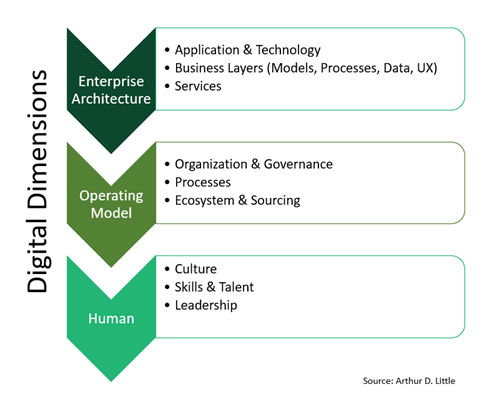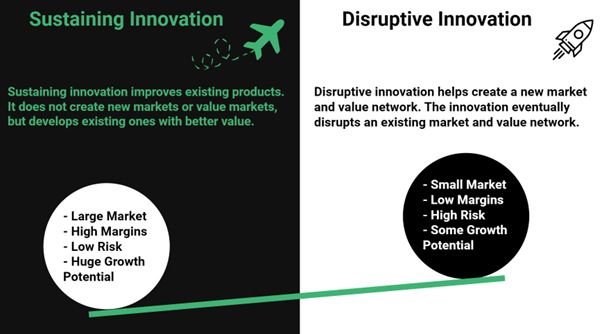
How can organizations hope to stay ahead when disruption lurks around every corner, ready to render them obsolete at a moment's notice?
In an era where digital investment is pivotal, CIOs must invest in technology to propel growth, reap financial rewards, and drive eco-wins. A survey across 81 nations signals heightened 2023 spending in cybersecurity (70%), BI/data analytics (53%), cloud (48%), AI (34%), and hyper-automation (24%) - essentials for thriving. Innovation is the elusive force that powers the engine of progress in the business world.
Yet, as business leaders, we often find ourselves grappling with a vexing dilemma: How do we not only initiate but also perpetually sustain innovation? This question reverberates through every organization’s business and technology leaders’ minds, leaving no one untouched by its gravity. Innovation is undeniably the lifeblood of a thriving organization. Still, it’s a challenge we all face - the relentless pursuit of staying ahead in a constantly changing world.
Before we delve into sustaining innovation, let’s take a moment to understand its nature. At its heart, innovation is about pioneering fresh ideas, methods, and products. It’s not a static concept but a dynamic force that propels progress and lays the foundation for growth and success.
Innovating isn't a one-time act but a continuous process. It is the perpetual quest to outpace the competition, predict market shifts, and meet the ever-evolving demands of customers. However, as we dive deeper into the world of innovation, we encounter a common conundrum – how do we keep the fires of innovation burning without depleting our resources and exhausting our teams? This article will explore sustaining innovation, its significance, strategies, and relevance across business domains and showcase how AI solutions can pave the way to sustainable and futuristic business models.
Different Types of Innovations
To fully grasp the concept of sustaining business innovation within projects & initiatives, it’s essential to understand the diverse innovation types, including:
- Product Innovation, which enhances new products to meet customer needs, boosting competitive advantage in business projects.
- Process Innovation, refining internal operations of business initiatives for greater efficiency.
- Service Innovation, enhancing project customer experiences through new or improved services.
- Business Model Innovation, rethinking operations, and engagement in business strategies.
- Marketing and Sales Innovation, developing novel strategies for engaging customers in projects.
- Technological Innovation, leveraging advancements like AI and IoT to drive innovation across business operations.
What Does Sustaining Innovation Mean?
Now that we have laid the groundwork, let's delve into understanding what sustaining innovation is. Essentially, sustaining innovation is about fostering continuous enhancements within your organization. It’s the practice of persistently refining your products, processes, or services without succumbing to the fatigue that often accompanies innovation.
groundwork, let's delve into understanding what sustaining innovation is. Essentially, sustaining innovation is about fostering continuous enhancements within your organization. It’s the practice of persistently refining your products, processes, or services without succumbing to the fatigue that often accompanies innovation.
Consider sustaining innovation as the meticulous upkeep of a high-performance vehicle. You don’t simply drive it until it breaks down; you change the oil, rotate the tires, and replace worn-out parts to ensure it continues to operate at its peak. Similarly, in a business context, sustaining innovation involves regular ‘maintenance’ and ‘upgrades’ that translate into ‘investments’ and ‘training’ of your products, projects, or services to ensure they continue to meet customer needs and stay competitive in the market.
Why Do You Need to Focus on Sustaining Innovation
The significance of sustaining innovation is immense. Leveraging modern analytical solutions is imperative to solving modern-day business problems. Here’s why it should be a priority for business and technology leaders:
- Competitive Edge in Project Delivery - In a business environment where competitors are constantly vying for the top spot, sustaining innovation models and AI-led solutions is your ticket to maintaining a competitive edge in project execution. It keeps your project offerings up-to-date and your stakeholders engaged.
- Stakeholder Satisfaction - Stakeholder expectations can be unpredictable. As their needs evolve, sustaining innovation and modern AI solutions ensure you meet their expectations, fostering satisfaction and retention.
- Cost-Effective Project Execution - Opting for incremental improvements through sustaining innovation and AI-driven solutions is more cost-effective than undertaking radical changes that require substantial project resources.
- Project Risk Mitigation - Relying solely on disruptive innovations can be risky for projects. Sustaining innovation provides a steady stream of enhancements, reducing the potential impact of market volatility on project outcomes.
- Stakeholder Confidence - Project stakeholders such as investors, sponsors, and team members are drawn to forward-thinking and adaptable initiatives. Sustaining innovation signals your commitment to long-term project success.
What Are Practical Ways Sustaining Innovation?
Now that we've established the significance of sustaining innovation in project execution let's delve into concrete strategies to ensure its realization. Below are effective methods to maintain a steady stream of innovation within your projects:
- Cultivate a Culture of Innovation - Create an environment that rewards innovation, especially AI-driven ideas, empowering team members to propose AI-led enhancements.
- Invest in Research and Development (R&D) - Dedicate resources to R&D, focusing on AI to continuously explore new possibilities and stay ahead of industry trends.
- Customer Feedback - Use customer insights to guide AI-driven project improvements, making their feedback central to your AI solution enhancements.
- Cross-functional Collaboration - Break down organizational barriers to enable diverse teams to collaborate, often leading to innovative AI solutions.
- Continuous Learning - Commit to your team's education in AI and modern technologies, promoting participation in AI-focused seminars and training.
- Open Innovation - Seek inspiration beyond your organization. Partner with external entities, universities, or startups to infuse advanced technology, ideas, and expertise into your projects.
- Data-Driven Insights - Use AI-powered data analytics to gain insights into customer behavior, market trends, and operational efficiency. Data-driven decision-making should be at the heart of your innovation efforts.
- Agile Methodologies - Implement agile methodologies in your project management processes. This allows you to adapt quickly to changing circumstances and iterate on your innovations.
Amidst many projects and tasks, harnessing the power of advanced analytical and predictive solutions is imperative. These solutions seamlessly integrate all aspects into a unified application, enabling continuous monitoring, proactive alerting, and efficient delivery of all initiatives.
Which Business Areas Is Sustaining Innovation Useful In?
A sustaining innovation model provides a flexible approach that can be applied across various business areas, including:
- Product Development - Enhance projects by incorporating AI solutions, ensuring your deliverables evolve with customer needs, and keeping your outcomes competitive and relevant.
- Customer Service - Improve project-related customer support processes with AI-led innovations, boosting satisfaction and fostering loyalty, which is pivotal for positive project outcomes and reputation.
- Marketing and Sales - Apply AI-driven marketing strategies to promote projects, reach new audiences, and expand project impact, which is crucial for tapping into new opportunities.
- Supply Chain Management - Leverage AI to optimize project supply chain processes, reducing costs and enhancing efficiency, which is key to timely and cost-effective project delivery.
- Human Resources - Use innovative AI-led HR practices in your projects to attract and retain the talent essential for driving project success and innovation.
- Financial Management - Adopt modern financial strategies enhanced by AI for project budgeting and profitability, empowering reinvestment in innovation and growth within project scopes.
- Information Technology - Update your project's IT systems and infrastructure with modern solutions, ensuring your projects leverage cutting-edge technology for maximum efficiency and innovation.
(The graphic below illustrates the digital dimension that should be considered for sustainable innovation).

Sustaining Innovation vs. Disruptive Innovation
It’s important to differentiate between sustaining and disruptive innovation, as each serves unique purposes.
Sustaining Innovation emphasizes gradual enhancements to current products, services, or processes, often using AI insights. It aims to maintain or slightly improve a company's market position by updating existing offerings to meet customer needs and stay competitive.
Key Aspects of Sustaining Innovation:
- Targets upgrades in existing offerings.
- Seeks to uphold or improve market presence.
- Utilizes established knowledge and AI insights, minimizing risk.
- Driven by customer feedback and market trends.
Conversely, Disruptive Innovation marks a significant departure by introducing novel, AI-driven offerings that could transform sectors and establish new markets.
Characteristics of Disruptive Innovation:
- Launches new AI-influenced offerings.
- Potential to revolutionize industries and form new markets.
- Involves higher risk due to the innovative leap and resource needs.
- Spurred by AI advancements and forward-thinking leadership.
Recognizing these innovations is crucial for project leaders' strategic planning and resource distribution, which they must combine to meet project goals, industry shifts, and customer demands.
(The graphic below illustrates the difference between sustaining innovation and disruptive innovation).

How to Sustain Innovation - Examples
Let’s look at some real-world examples of sustaining innovation in action:
- Apple iPhone - Apple consistently enhances its iPhone with each new iteration, adding new features and improving performance to meet evolving consumer expectations. This continuous improvement has helped Apple maintain its position as a leader in the smartphone market.
- Toyota’s Hybrid Technology - Toyota’s pioneering hybrid technology, as seen in the Prius, is a testament to sustaining innovation in the automotive industry. It continuously improves fuel efficiency while maintaining the core hybrid concept, making Toyota a frontrunner in eco-friendly vehicles.
- Amazon Prime - Amazon continually enhances its Prime membership program by adding new benefits, such as streaming services and faster shipping options. This constant innovation keeps customers engaged and loyal, contributing to Amazon’s success in e-commerce.
- Coca-Cola - Coca-Cola has mastered sustaining innovation by introducing new flavors and packaging while preserving the iconic taste of its original product. This business strategy has allowed Coca-Cola to remain a beloved brand worldwide.
- Microsoft Office - Microsoft’s Office suite undergoes regular updates, introducing new features and improvements. This commitment to sustaining innovation ensures that Office remains a go-to productivity solution for individuals and businesses.
Engage Your Team in Sustaining Innovation
One of the key elements of sustaining innovation in project execution is engaging your team. After all, innovation isn’t a one-person show; it’s a collective effort. Here’s how to get your team on board:
- Empowerment - Encourage ownership of project ideas and execution strategies, creating a valued and impactful environment.
- Recognition - Acknowledge innovative contributions within projects, from public praise to financial rewards, promoting a culture that values innovation.
- Training and Development - Provide training relevant to modern solutions, supporting your team's growth and equipping them for project challenges.
- Cross-functional Teams - Promote collaboration across departments for diverse perspectives and breakthrough ideas in projects.
- Communication - Maintain open communication, ensuring the team understands the project's innovation goals. Regular updates keep everyone aligned and motivated toward success.
Conclusion
In conclusion, sustaining innovation is vital for continuous business progress. Thoroughly understanding its various forms and the critical importance of fostering a culture that embraces sustaining innovation is key. Business leaders must proactively leverage modern technology and advanced predictive intelligence solutions to eliminate any traces of innovation fatigue effectively. These essential solutions provide the necessary compass to navigate the dynamic and often unpredictable business landscape confidently, accurately predict market shifts, and precisely anticipate customer needs to achieve sustainable innovation and success in their ventures.
Leveraging advanced AI solutions is key in the ever-shifting business landscape and aligns with evolving customer demands for enduring success. TrueProject is a vanguard in the realm of sustaining innovation through predictive intelligence. This isn't merely a solution; it's a revolution in harnessing AI to streamline information synthesis and foresee potential project hurdles. With its unique Derived Insight feature, TrueProject doesn't just react; it anticipates, analyzing vast pools of data and stakeholder insights to flag possible concerns before they escalate. This proactive approach ensures your projects are managed and steered precisely, safeguarding against risks and aligning with strategic objectives.
TrueProject offers a foresight of your project landscape, empowering your organization to operate with heightened efficiency, creativity, and innovation. It's transforming the innovation ecosystem, ensuring that your projects don't just survive but thrive while achieving and sustaining the innovation frontier. With TrueProject, you're not just participating in the sustainable innovation race but leading it.
More information on TrueProject at trueprojectinsight.com

About the Author:
Nisha Antony is an accomplished Senior Marketing Communications Specialist at TrueProject, a leader in predictive intelligence. With over 16 years of experience, she has worked as a Senior Analyst at Xchanging, a UK consulting firm, and as an Internal Communications Manager on a major cloud project at TE Connectivity. She is an insightful storyteller who creates engaging content on AI, machine learning, analytics, governance, project management, cloud platforms, workforce optimization, and leadership.
Endnotes
- Crestcom Leadership Team. “Why You Need To Focus On Sustaining Innovation.” Crestcom: April 06, 2017. https://crestcom.com/blog/2017/04/06/why-you-need-to-focus-on-sustaining-innovation/
- Catherine Cote. “SUSTAINING VS. DISRUPTIVE INNOVATION: WHAT'S THE DIFFERENCE?” Harvard Business School Online: February 03, 2022. https://online.hbs.edu/blog/post/sustaining-vs-disruptive-innovation
- Rokon Zaman. “Incremental Approach for Sustaining Innovation.” The Waves: August 09, 2020. https://www.the-waves.org/2020/08/09/incremental-approach-for-sustaining-innovation/
- Hannah Turner. “A deeper dive into the 4 Types of Innovation: Sustaining Innovation.” Graduate Management Admission Council: June 26, 2023. https://www.mba.com/business-school-and-careers/why-business-school/sustaining-innovation
- MarketsandMarkets Team. “The Global Innovation Market Research 2023” MarketsandMarkets: 2023. https://www.marketsandmarkets.com/Market-Reports/innovation-management-market-238981272.html
- Michael Majster, Joeri Samyn, Victor Debray. “DIGITAL & SUSTAINABILITY: THE NEW CONVERGENCE”. Arthur D Little: May, 2023. https://www.adlittle.com/th-en/insights/viewpoints/digital-sustainability-new-convergence





